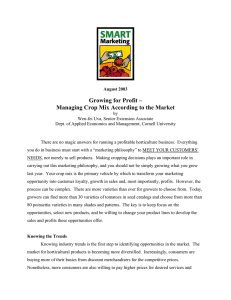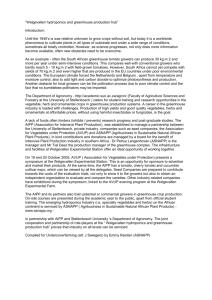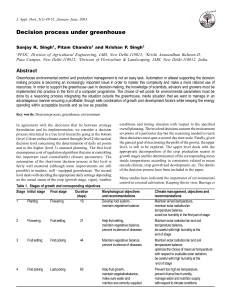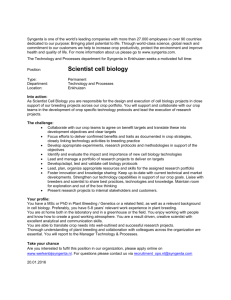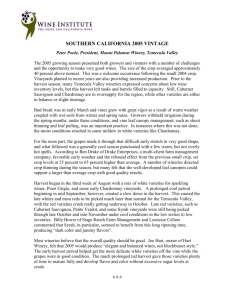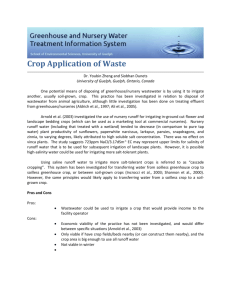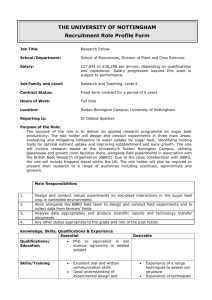Greenhouse Study – Findings
advertisement
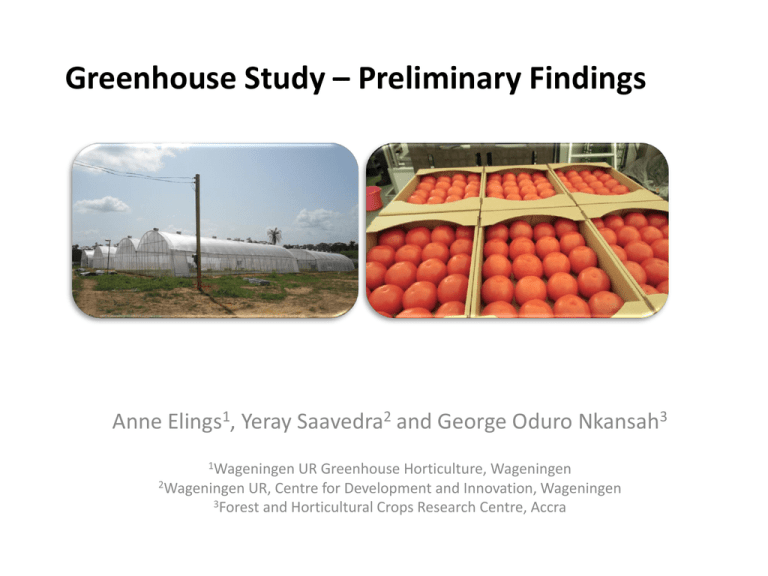
Greenhouse Study – Preliminary Findings Anne Elings1, Yeray Saavedra2 and George Oduro Nkansah3 1Wageningen UR Greenhouse Horticulture, Wageningen UR, Centre for Development and Innovation, Wageningen 3Forest and Horticultural Crops Research Centre, Accra 2Wageningen Climate, locations and crops • Hot and humid – Kade (UG, FOHCREC) and Volta (Freshfields, Tagagi) • Slightly cooler – Kumasi (CRI) and Wenchi (Tomacan) • Dry – Tamale (SARI, New Energy) Observation: • Possible to grow the main vegetables (Asian and local) and fruit vegetables (tomato, sweet pepper, chillies, cucumber) in all three zones. Greenhouse installation Main observations: • Low-tech - gravity-based fertigation system • More advanced systems – electricity driven pump to ensure fertigation • Wide greenhouses - mechanical vents for good air circulation • Computerized systems that base fertigation on indoor or outdoor climate information, or on soil moisture content, are not in use in Ghana • The availability and costs of electricity is a crucial element in up-scaling the technology level Seeds and varieties and substrates used Main observations: • F1 hybrids and open-pollinated varieties (OPVs) • Hybrids supplied by Dizengoff, EastWest, PopVriend, etc • Seeds availability concentrated in Accra • Most varieties imported from foreign companies • Local breeding companies do not exist • Some breeding done by FOHCREC-UG, CRI, SARI for supply to farmers/growers Crop protection agents Main observations • Any pesticide available is used in Ghana - legal or not legal • Growers that claim to be organic use chemicals • Crop labelling is not always reliable • Spraying techniques and schemes are sub-standard • Resistance build-up in pest populations against active ingredients probably easily occurs • High minimum residue levels (MRLs) in products -unacceptable • Substrate include – Cocopeat , CRH and soil – Substrate cultivation prevent crop infection with soil-borne diseases (e.g. bacterial wilt) and better regulation of nutrients to the crop Fertilizers Main observations: • NPK 19-19-19 • Tank A/B fertilizer system not available as in other countries • Ghana water and chemical fertilizers are mixed in one tank from which the crop is drip irrigated • The EC and pH of the supply solution are sometimes checked but not by all growers • Measurement of soil characteristics rarely takes place • Some growers enrich their soil with humus / organic waste Energy Main observations: • Gravity used to supply water to plants • Use of pumps for bringing water to the plants requires continuous availability of electricity • Source of electricity is the grid (not fully reliable) – affect crops • SVL and New Energy integrates solar panels to greenhouses • Solar energy is a good and reliable energy source where solar radiation is high and often available. And must be encouraged Production level Main observations: • Production levels are low because of poor pest and disease management, poor greenhouse constructions and poor crop management. • Some farmers obtain higher production levels, demonstrating room for improvement • Along with such yield improvement, quality should and can be improved. • Post-harvest cold chain logistics are absent. Summary • A business case, expected to be commercially viable, do exist. • Major bottlenecks are: – Knowledge, and its exchange – Seeds and varieties, crop protection and management – Greenhouse construction – An organized sector, legislation and implementation – Water and energy infrastructure and cold chain logisitics – Curriculum development for teaching • Greenhouse commercial activity however looks rosy for the future • Key advice is to: – Establish collaboration between the private and public breeding sector – Conduct well-organized and standardized variety trials

